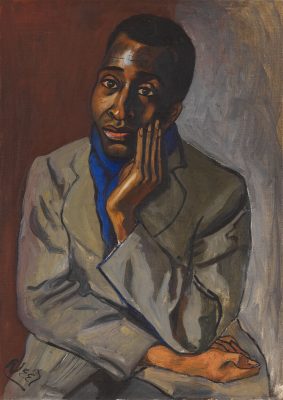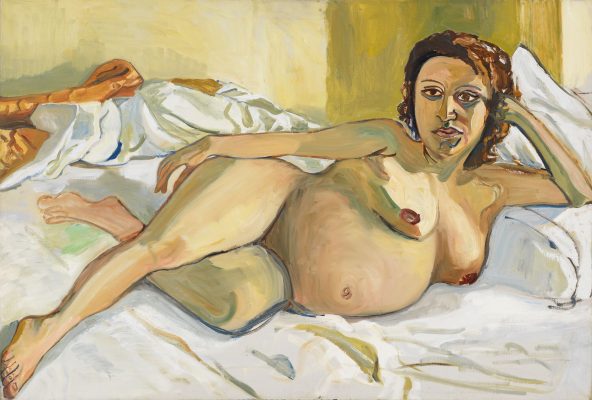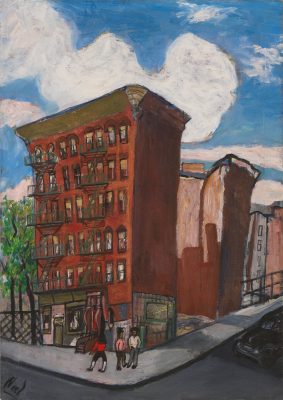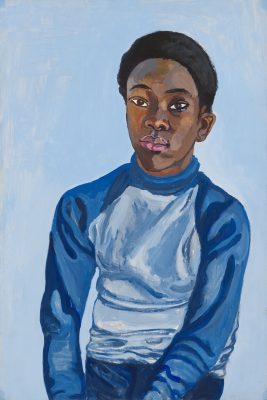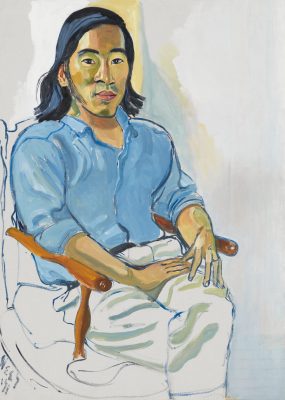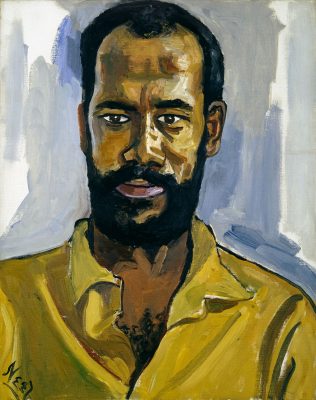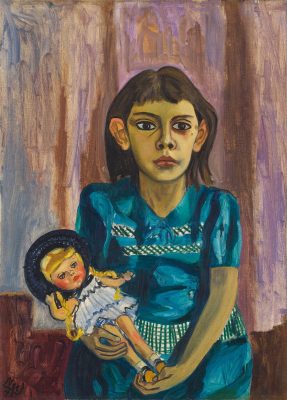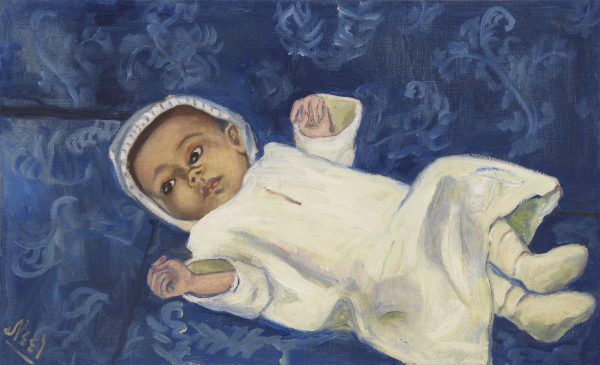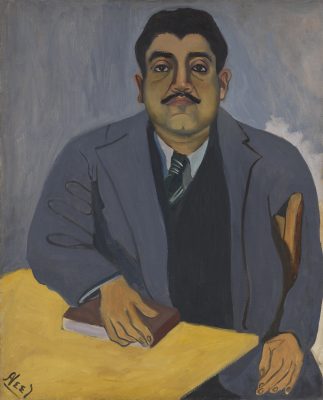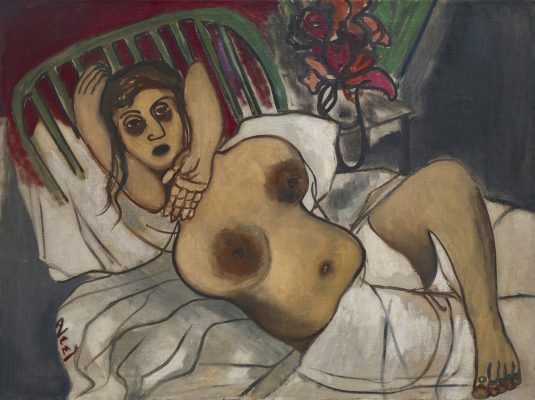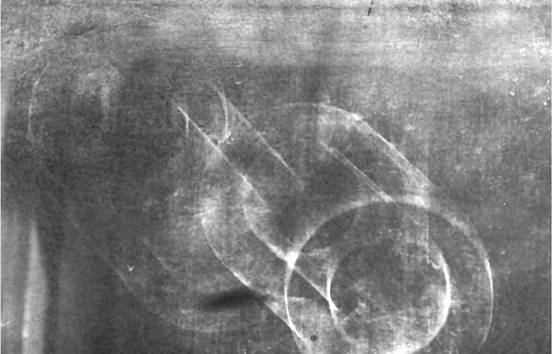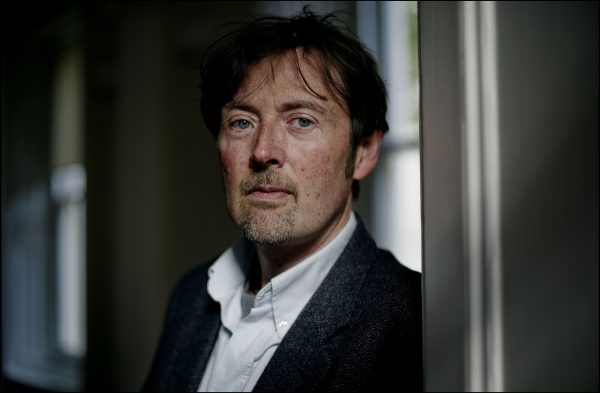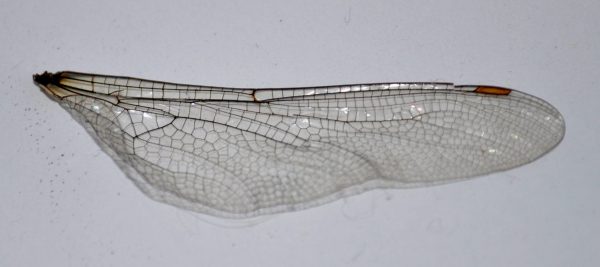From the first time I saw Alice Neel’s portraits, I wanted to see the world as she did. Neel was the Matisse of the brownstones: an exceptional colourist, immaculate stylist, and a collector of New York souls. Her particular mode of vision has attracted many, and later in life, she gained famous admirers. Frank O’Hara sat for her in 1960, and after Andy Warhol was shot by Valerie Solanas, it was Neel who painted him, his frail, naked torso stitched up like a rag doll mended one too many times.
Today, it would be easy to see her as a portraitist of New York’s canonised ‘culturati’, but she painted hundreds of the city’s residents, treating taxi drivers, kids, actors, and activists with the same candour and attention. For the exhibition ‘Alice Neel, Uptown’, the writer Hilton Als has brought together her portraits of people of colour residing in Upper East Side and Spanish Harlem, two largely immigrant neighbourhoods in which she lived over the course of five decades.
The pairing of Neel and Als shows two artists who are both in sync and out of time. Neel was born into a white, middle-class family in Philadelphia, and moved to New York with her husband, the Cuban painter Carlos Enríquez Gómez, in 1927. Als, a staff writer at the New Yorker, grew up in a black family in Brooklyn, and hit adolescence in the decade that Neel died. Als shares with Neel a stylistic affinity – chicness served with a twist of Freudian introspection, and steeped in New York modernism – and a particular flair for studying character. For Als, that character is often himself, and in prose passages dotted through the publication that accompanies the exhibition (also titled Alice Neel, Uptown), he uses Neel’s portraits as triggers to reflect upon his own life story.
The exhibition travelled to London’s Victoria Miro after opening at David Zwirner in New York, and some of the most extraordinary paintings on show were those of men of physical and political action, in moments of calm. In Ballet Dancer (1950), an un-named man lounges across a sofa, emanating the erotic languor of a well-trained body in repose, the cool blue of the upholstery echoed in the supple tangle of his limbs. The vociferous critic Harold Cruse, co-founder of Harlem’s Black Arts Theatre, and author of The Crisis of the Negro Intellectual (1967), sat for Neel in 1950. In the resulting painting, he rests a slender, elongated hand softly against his cheek, his entire figure enveloped by a backdrop of deep burgundy and dull silver. A flash of light, picked out in white paint, illuminates his forehead, turning his face into a beacon, so that Cruse appears on the canvas like a guide in the gloam.
Throughout the exhibition and the book, writer and painter enter into a strange dance of authorship, in which Als begins to speak through Neel, as if treating her as a host body for him to inhabit. The process starts in the book’s introduction, when he returns to the subject of his father. Like Cruse, or the un-named ballet dancer, Als say that his father, the only child of West Indian immigrants, would have been ‘one of her guys’. Later, beside a portrait of Stephen Shephard from 1978, a coquettish young man wearing a handlebar moustache and a summery blue bomber jacket, Als ponders the subject’s sexuality. ‘Just look at him, in all his sexy knowingness. Is he gay?’ he writes, before pirouetting into a two-page reminiscence of his own, hedonistic youth.
Neel viewed her role as a portrait painter as akin to that of analyst. As Als explains, confirming her status as painting’s shrink-elect, ‘that’s the thing about Neel – you really have to search your own shit, your own past, in order to glean what she was doing.’ Her aim, as she put it, was to coax from her subjects their ‘character and social standing – what the world has done to them and their retaliation’. Typical of her style is the manner in which conventional perspective takes a hit, in favour of enhancing the psychological sensibility of her subjects. Limbs shorten, or extend, necks disappear, grown men shrink to the size of children, in too-big borrowed clothes, and children swell to the size of adults. In the publication, there are numerous portraits of a Latin American boy named Georgie Arce, who sat for Neel throughout the 1950s as he approached his teenage years. Neel’s studies of the boy capture a time when irregular spurts of mind and body produce gaps in the shell of a character, opening up sight lines to an interior world rarely glimpsed once adulthood closes in. Sometimes, Arce’s hands are painted preposterously large, his teeth sharp with the menace of manhood. Elsewhere he is the picture of naivety, wrapped in his clothes like a child in a blanket.
‘Alice Neel, Uptown’, is not the first time Als has blurred the lines between his identity and that of a white woman. In his 2013 book of essays White Girls, the ‘white girl’ is an emblem of a restricted type of power, the anointed love-object of a culture organised around the wants of pale-skin and patriarchy. Als rolls out this moniker to men who have been shaped by the object in question – insider-outsider figures who suffer and excel in such ivory towers, or have endeavoured to build their own. Among their number are Michael Jackson, Truman Capote, Eminem and Hilton Als himself. White Girls may not be an explicit feature of ‘Alice Neel, Uptown’, but its theme has been put into practice. As Neel becomes the medium through which Als expresses his desires, his history, his psychology, two white girls combine across the divides of race and sexuality.
Als provisionally titled the exhibition ‘Colored People’. The name may have changed, but the question of ethnicity runs through the heart of the show – whether Als’ relationship to Neel, or Neel’s relationship to her subjects. Neel’s particular genius (and I use that word advisedly) was her attentiveness to the individual; on her canvases, nobody is put to symbolic use. Als writes that ‘she did not treat colored people as an ideological cause’, and it was empathy, and not sympathy, that drove her. It is worth noting, in contrast, the manner in which cause-ism has resulted in the high-profile undoing of white artists in 2017, first with the backlash following Dana Schutz’s painting of the dead Emmett Till at the Whitney Biennial, and then with the anger caused by the installation of Sam Durrant’s sculpture of a gallows Scaffold (2012) at Walker Arts Center. Both artists intended to highlight racist US history, but in returning to such symbolic spectacles, largely succeeded in aggravating the wound.
Als also points out that when, in 1971, the Whitney failed to consult a single person of colour in the curatorial process for the exhibition ‘Contemporary Black Artists in America’; Neel picketed the museum. Yet despite her evident solidarity, and the attention she gave to the individual subject in paint, there are moments beyond the canvas when her approach to the impoverished residents of Harlem bears the hallmark of an outsider’s gaze. Such is the case with her poem, ‘I Love You Harlem’, displayed at Victoria Miro in a vitrine. ‘I love you Harlem’, the poem begins, ‘Your life your pregnant/ Women, your relief lines/ Outside the bank, full/ Of women who no dress/ In Saks 5th Ave would/ Fit, teeth missing, weary/ Out of shape, little black/ Arms around their necks’. In hands other than Als’, such romanticism might not be received so kindly.
Als approaches the curation of ‘Alice Neel, Uptown’ as an intricate act of power-balancing. As a result, the exhibition can be interpreted in a number of ways: an affinity between artists unbounded by time or identity categories, a taking back of narrative from white hands to black, a man speaking over a woman. It works, because it is all these things at once, and yet it is never without affection. Like a pair of empathetic parasites, both writer and painter provide each other with something they need, but do not otherwise possess. By attaching himself to Neel’s paintings, Als makes use of the great analyst-painter to draw out his own biography, and illustrate it in brilliant style. And in return, by blurring the line between what is his and what is hers – by becoming Alice Neel – Als merges her gaze with his own, bringing her closer to her subjects than her whiteness may otherwise allow her. Many have wanted to see like Neel, and to be seen by her, but none, perhaps, have made such gains as Hilton Als.
